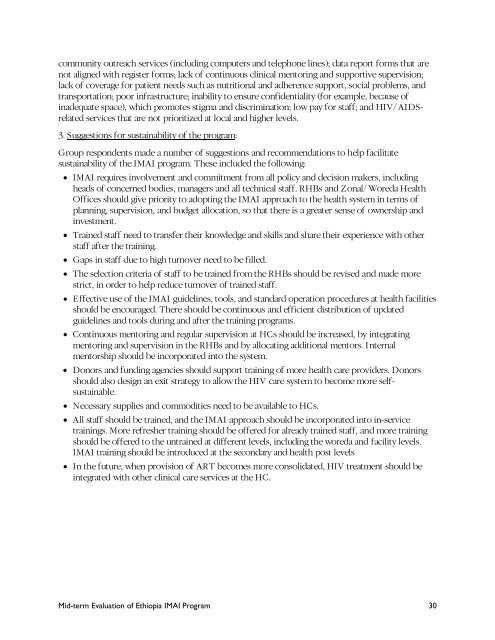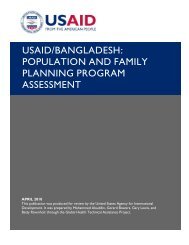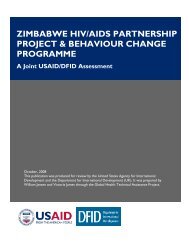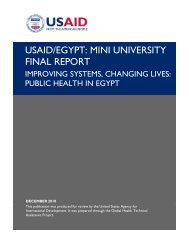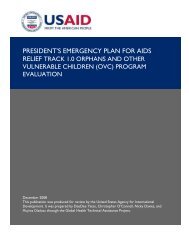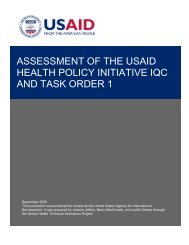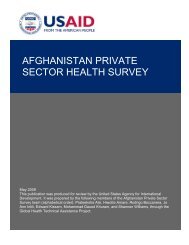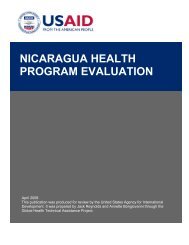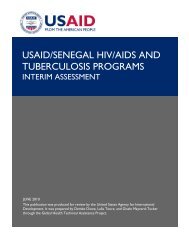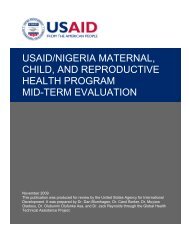community outreach services (including computers and telephone lines); data report forms that arenot aligned with register forms; lack <strong>of</strong> continuous clinical mentoring and supportive supervision;lack <strong>of</strong> coverage for patient needs such as nutritional and adherence support, social problems, andtransportation; poor infrastructure; inability to ensure confidentiality (for example, because <strong>of</strong>inadequate space), which promotes stigma and discrimination; low pay for staff; and HIV/ AIDSrelatedservices that are not prioritized at local and higher levels.3. Suggestions for sustainability <strong>of</strong> <strong>the</strong> program:Group respondents made a number <strong>of</strong> suggestions and recommendations to help facilitatesustainability <strong>of</strong> <strong>the</strong> IMAI program. These included <strong>the</strong> following:• IMAI requires involvement and commitment from all policy and decision makers, includingheads <strong>of</strong> concerned bodies, managers and all technical staff. RHBs and Zonal/ Woreda HealthOffices should give priority to adopting <strong>the</strong> IMAI approach to <strong>the</strong> health system in <strong>term</strong>s <strong>of</strong>planning, supervision, and budget allocation, so that <strong>the</strong>re is a greater sense <strong>of</strong> ownership andinvestment.• Trained staff need to transfer <strong>the</strong>ir knowledge and skills and share <strong>the</strong>ir experience with o<strong>the</strong>rstaff after <strong>the</strong> training.• Gaps in staff due to high turnover need to be filled.• The selection criteria <strong>of</strong> staff to be trained from <strong>the</strong> RHBs should be revised and made morestrict, in order to help reduce turnover <strong>of</strong> trained staff.• E ffective use <strong>of</strong> <strong>the</strong> IMAI guidelines, tools, and standard operation procedures at health facilitiesshould be encouraged. There should be continuous and efficient distribution <strong>of</strong> updatedguidelines and tools during and after <strong>the</strong> training programs.• Continuous mentoring and regular supervision at HCs should be increased, by integratingmentoring and supervision in <strong>the</strong> RHBs and by allocating additional mentors. Internalmentorship should be incorporated into <strong>the</strong> system.• Donors and funding agencies should support training <strong>of</strong> more health care providers. Donorsshould also design an exit strategy to allow <strong>the</strong> HIV care system to become more selfsustainable.• Necessary supplies and commodities need to be available to HCs.• All staff should be trained, and <strong>the</strong> IMAI approach should be incorporated into in-servicetrainings. More refresher training should be <strong>of</strong>fered for already trained staff, and more trainingshould be <strong>of</strong>fered to <strong>the</strong> untrained at different levels, including <strong>the</strong> woreda and facility levels.IMAI training should be introduced at <strong>the</strong> secondary and health post levels• In <strong>the</strong> future, when provision <strong>of</strong> ART becomes more consolidated, HIV treatment should beintegrated with o<strong>the</strong>r clinical care services at <strong>the</strong> HC.Mid-<strong>term</strong> Evaluation <strong>of</strong> Ethiopia IMAI Program 30
V. CONCLUSIONS AND LESSONS LEARNEDA. Impact <strong>of</strong> IMAI on HIV Care, Treatment, and Support Services at <strong>the</strong> HealthCenter Level1. IMAI has had many positive benefits for HIV-infected patients, including improved HIV care and access toART. Despite <strong>the</strong> many challenges inherent in <strong>the</strong> ambitious challenge <strong>of</strong> training thousands <strong>of</strong>health workers and implementing IMAI at hundreds <strong>of</strong> HCs throughout E thiopia, it is withoutdoubt a worthwhile undertaking. Decentralization and IMAI have already improved access toHIV care and services, including PMTCT and ART, for a large number <strong>of</strong> people in E thiopiawho ei<strong>the</strong>r would not have access to such services or who would have to travel long distances toreceive care at overcrowded hospital clinics. Benefit to HIV-infected patients is <strong>the</strong> mostimportant contribution <strong>of</strong> this program and reason to continue to support it.2. IMAI has had many positive benefits for HCs and <strong>the</strong>ir staff. In addition to <strong>the</strong> benefit for patients,health staff interviewed as part <strong>of</strong> this <strong>evaluation</strong> also felt that <strong>the</strong>y had benefited fromimplementation <strong>of</strong> IMAI. Those who were interviewed largely felt that <strong>the</strong>ir knowledge and skillshad increased, and that <strong>the</strong>ir capacity to provide HIV care had improved. National guidelines,national training curricula, and data recording tools have all been developed and are very useful in<strong>the</strong> actual implementation <strong>of</strong> IMAI and comprehensive HIV care. HC staff felt that <strong>the</strong>ircredibility as clinical care providers in <strong>the</strong> eyes <strong>of</strong> <strong>the</strong> community had been increased, improvingboth <strong>the</strong>ir own job satisfaction and <strong>the</strong> willingness <strong>of</strong> patients to seek care at HCs. Throughrealization <strong>of</strong> all <strong>the</strong>se benefits, task shifting <strong>of</strong> health staff (a key component <strong>of</strong> <strong>the</strong> national planto provide decentralized HIV care) has been reinforced. IMAI has had many positive benefits incapacity building <strong>of</strong> <strong>mid</strong>dle-level cadres to manage HIV/ AIDS patients.3. IMAI has in most HCs been associated with significant increases in client utilization. The <strong>evaluation</strong> teamrequested information on <strong>the</strong> number <strong>of</strong> clients utilizing a variety <strong>of</strong> HIV-related services in <strong>the</strong>year before IMAI was implemented at <strong>the</strong> HC and in <strong>the</strong> year after. In <strong>the</strong> majority <strong>of</strong> HCs where<strong>the</strong>se data were available, <strong>the</strong> team found that <strong>the</strong> number <strong>of</strong> clients seeking HIV services at HCshad significantly increased. Although <strong>the</strong>re are multiple reasons for this doubling <strong>of</strong> clinicalcapacity and client utilization, <strong>the</strong>se data support <strong>the</strong> benefits <strong>of</strong> and need for IMAI at <strong>the</strong> HClevel. Although increased utilization was noted at <strong>the</strong> majority <strong>of</strong> HCs visited by <strong>the</strong> <strong>evaluation</strong>team, it was noted that some HCs were providing ART to very few patients, even after IMAIimplementation.4. The clinical skills <strong>of</strong> most health workers at <strong>the</strong> HC level need significant improvement and support in order toprovide quality HIV care. Although <strong>the</strong> <strong>evaluation</strong> team found that most clinicians at <strong>the</strong> HC levelwere conscientious and dedicated, <strong>the</strong>ir actual abilities to provide clinical care and manage <strong>the</strong>many challenging issue related to ART and o<strong>the</strong>r HIV care were highly variable. Observation <strong>of</strong>nurses or health <strong>of</strong>ficers providing care found that <strong>the</strong>se individuals were generally aware <strong>of</strong> andfollowed established protocols, such as guidelines concerning when to initiate ART. In 14 HCswhere <strong>the</strong>se data were specifically collected, about 56% <strong>of</strong> staff reported feeling confident and didnot find any difficulty in providing HIV care. However, clinical observations <strong>of</strong> nurses and health<strong>of</strong>ficers providing HIV care found that <strong>the</strong>ir ability to provide follow-up <strong>of</strong> those on ART, toidentify and manage complications <strong>of</strong> HIV and ART (including ART side effects), to monitor fortreatment failure, and to recognize, evaluate, and manage OIs and o<strong>the</strong>r HIV-related diseases was<strong>of</strong>ten limited. History and physical examination skills were highly variable, and clinical observationrevealed that not all individuals were aware <strong>of</strong> and followed guidelines for clinical and laboratoryMid-<strong>term</strong> Evaluation <strong>of</strong> Ethiopia IMAI Program 31


